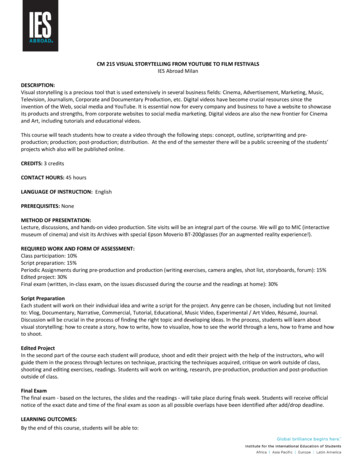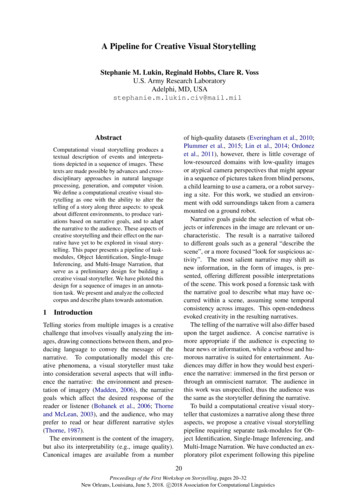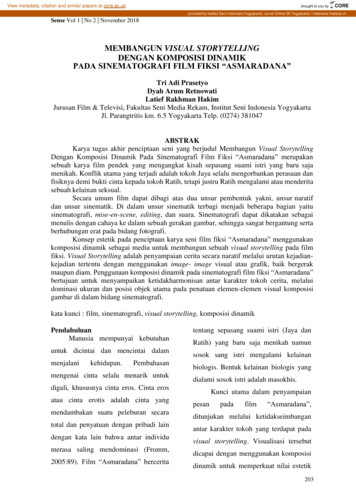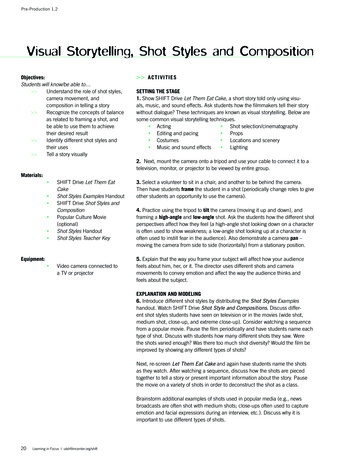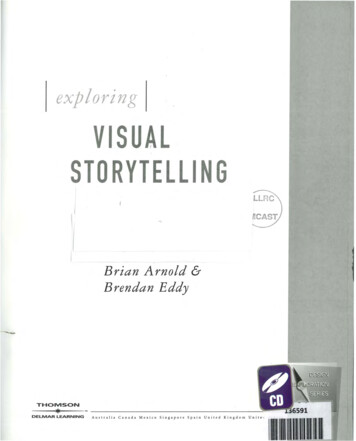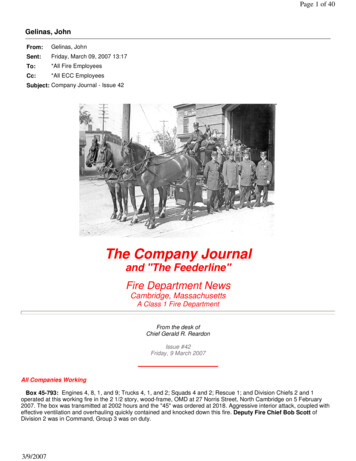
Transcription
Leading ChangeThrough StorytellingHow Leaders Inspire ActionThrough Storytellingwww.stevedenning.comThese ling.pdf
How do you: inspire enduring enthusiasmfor a cause? connect with risk-averse, diverse,difficult, cynical audiences? .at work, with clients,in the community, in the family?
I will talk aboutThe power ofstorytellingBut also about:The limits of storytelling
How do you inspirepeople towantto change?
Three kinds of leadership books.“Tell them!”“Give themreasons!”“Inspirethem!”
WARNINGWhat you are about to hear may seem: Contrary to most of what you learned in college At odds with the way most organizations are saidto be run. Challenging the basic premises of the Westernintellectual tradition, ever since Plato’s Republic. Disturbing, because it may raise issues with some of thedeepest beliefs of your lifeFeel free to step outside!
nd2WARNING“If business leaders do notimmediately grasp the vital insightsoffered by this book,both they andtheir organizationsare doomed.”Financial Times: August 29, 2007
Using storytelling to inspire changeThe Western intellectual traditionProblem?Analysis?Solution!?Effective presentation to get actionGet theirattentionElicitdesireReinforcewith reasons
Exercise #1Tell a 60 second storyabout:Either A time when you found outwhat your organizationis really good ator A time when you faced difficulty oradversity in your work
Greatcommunicationsmake the complexsound simple
Simpledoesn’t meanmisleading
Simple!Authentic!Lessismore!Succinct!With feeling!
What’smy story?
The Language of LeadershipPreparing to leadThe storyof thechangeThe storyof personwho mustchangeEffective presentation to get actionGet theirattentionElicitdesireReinforcewith reasons
Preparing to lead: 1. The story of the change1. Understandingthe story of thechange
Preparing to lead: 1. The story of the changeGetting clear on the change idea Big problem in change:Leaders often don’t make up their mindexactly which change.
Preparing to lead: 1. The story of the changeGetting clear on the change idea How do youchop wood?Annie Dillard:The Writing Life
Preparing to lead: 1. The story of the changeGetting clear on the change idea How does a karateexpert breakthe brick?Susan Scott:Fierce Conversations
Preparing to lead: 1. The story of the changeGetting clear on the change idea BenZander
Preparing to lead: 1. The story of the changeGetting clear on the change idea
Preparing to lead: 1. The story of the changeGetting clear on the change idea Fix on it with laser beam intensity
Preparing to lead: 1. The story of the changeGetting clear on the change idea ExerciseFocus on your priority change message.It will have two parts.(a) what’s the problem ?(b) what would the world look likeif the problem was fixed?
Preparing to lead: 2. The follower’s story2. Understanding thestory ofthe person who needsto change
Preparing to lead: 2. The follower’s storyExerciseGetting to the level of the unique individualTell the story of a person who doesn’t want to changeas persuasively and coherently as you can.What are his values? His experiences? His goals?The story will always end:“That’s why this person does not want to change.”
Preparing to lead: 2. The follower’s storyGet into groups of three: The first person tells the story of the person who doesn’twant to change in the third person. It ends: “That’s whythey don’t want to change.” The second person tells the same story in the firstperson. It ends: “And that’s why I don’t want to change.” The third person tell the same story in the secondperson. It ends: “And that’s why you don’t want tochange.”
The Language of LeadershipPreparing to leadThe storyof thechangeThe storyof personwho mustchangeEffective presentation to get actionGet theirattentionElicitdesireReinforcewith reasons
First,get theirattention!
Today’s audiences
Getting the listener’s attentionHow do you get people’s attention? unexpected relevant negative
Getting the listener’s attentionYour story ofadversityGet theirattention“How you coped with adversity”ElicitdesireReinforcewith reasons
Getting the listener’s attentionDave Logantries toget his listener’s attention
Getting the listener’s attention
Getting the listener’s attentionHow didAl Goreget people’s attention?
Getting the listener’s attention
Getting the listener’s attentionOur problemswill get worse“The situation is deteriorating!”Our problemnow“Our problem now ismuch worse than you think!”Your story ofadversity“How you coped with adversity”Get theirattentionElicitdesireReinforcewith reasons
WARNINGWhat you are about to hear may seem: Contrary to most of what you learned in college At odds with the way most organizations are saidto be run. Challenging the basic premises of the Westernintellectual tradition, ever since Plato’s Republic. Disturbing, because it may raise issues with some of thedeepest beliefs of your life
20 DEVICES TO GET ATTENTIONGENERALLY EFFECTIVEThe audience’s problemsHow you handled adversityA warningA challengeA questionA metaphorSomething unexpected.Share something of valueAdmission of responsibilityA relevant musical performanceMODERATELY EFFECTIVEThe real thingA surpriseAn extraordinary offerThe story of an pportunityfor the audience.A springboard storyA jokeAn imageGENERALLY INEFFECTIVEHow the conclusions werereachedThe story of who yourcompany isFacts, data, analyses.
Stimulating desire for changeNext,stimulate theirdesire forchange!
Stimulating desire for changeThe keychallengeofcommunicatingchangeGet theirattentionElicitdesireReinforcewith reasons
Stimulating desire for changeHow do you stimulate desire for change? positive memorable lets the listener contribute generates a new story
Stimulating desire for changeHow do you stimulate desire for change? positive memorable lets the listener contribute generates a new story
FACTIn June 1995, a healthworker in Kasama, Zambialogged on to the CDC website in Atlanta and got theanswer to a question on howto treat malariaJune 1995, not June 2015A small remote town, not the capitalZambia, not a middle income countryCDC, not the World Bank
It was September 1998 The financial world was in a shambles - The Asian miracle had crumbled- Japan was mired in endless recession.- Russia had come unstuck in mid-August- Brazil was teetering on the brink.- Europe was struggling with the Euro.- The dollar and the stock exchange weregyrating wildly.
It was September 1998 DefineI was asked toknowledgemake amanagementpresentationor die!!!
August 20, 1998Pakistan Government seeksurgent advice on prematurepavement failureand wants to trya different technologyIn the pastthe Bank would not have beenable to provide valuableinput by thetight deadline
NowBank staff in fieldoffice contacts theRoad Network forurgent help
In-house response;task manager inJordan givespromising experiencein JordanSame day
Argentina field officeOverview ofexperience in Asia,Australia and Africa,Same day
External response;CEO, South Africannational roads agencycites significantexperiencewith the technology
Client gets theglobal experience,just enough,just in time,Just for you
KnowledgebaseSouth Africa,Jordan otherexperienceThe experience willbe edited for re-useand enteredinto the knowledge base
KMSJordan, SouthAfrica, otherexperienceIn futureThe client will be ableto get this materialfrom the Web
While technology is a facilitatorSharing depends on eTaskmanagerJordanField office,PakistanHead,SA HighwayAuthority
September 1998The springboard storyThis is theLet me kind of That’sremarkabletell youorganizationhow quicklyaboutweare goingPakistanImagineifwe couldrespondto behadwe couldthis kind ofcapability todeal with ourproblems
Stories can . . Entertain . Convey information . Preserve cultures . Build relationships and communities . Change organizations
Using story as a toolrequires understandingthe pattern underlyingthe narrative
We are not talking about this .
We are not talking about this .Let’s all gather roundthe corporate campfire
Springboard storytellingStorytelling that can communicatea complex idea and spark action.Springboard storyPurposeStory to stOutcomeAction
November 19, 2000THE RIGHT THINGStorytelling Only Works if Tales Are TrueBy JEFFREY L. SEGLIN . “One of my rules is: NeverRobert Metcalfe3Com Corporationlie ”
What is a true story?Not just a story without inaccuracy .e.g. 700 happy passengers reachNew York after the Titanic’smaiden voyage!
1.Springboard storytellingStorytelling that can communicatea complex idea and spark action.Springboard storyPurposeStory to stOutcomeAction
The findings of neuroscienceHuman brainCortex
The findings of neuroscienceHuman brainCortexMammal BrainLimbic system
The findings of neuroscienceHuman brainCortexMammal BrainLimbic systemReptile BrainNot smartbut quick
Story with an unhappy endingHuman brainCortexFight orflight!Mammal BrainLimbic systemReactionis fasterthanconsciousthought!Reptile Brain
Story with a happy endingHuman brainCortex“Warm floatyfeeling”Endogenous opiaterewardMammal BrainReptile Brain
1.Springboard storytellingStorytelling that can communicatea complex idea and spark action.Springboard storyPurposeStory to stOutcomeAction
The springboard storyThere are two listeners Let metell youTheListeneraboutthat I seeZambiaJust think ofthe emailsbuilding up inmy office!The littlevoice in thehead
The springboard storyHow do you stimulatethe little voice in the head?You tell a story in a way thatelicits a second story (You give the littlevoice something to do )
The springboard storyWhat if wetried thisin roads?Let metell youabout whathappened inZambiaMaybethis couldwork infinance?Could thishelp us inRussia?
The springboard storyWe would needbudgets .We would needto get peopleinvolved .Everybodyloves theirown creation!Of course, wewould needto get organizedImagine if I hada websitelike that .Why don’twe do it?
Reinforce with reasonsFinally,reinforce withreasons!
Reinforce with reasonsNegativestoryto getattentionGet theirattentionPositivestoryto getactionNeutralstoriesto explainwhat, how& whyStimulatedesireReinforcewith reasons
Who can be a springboard storyteller?Everyone!
Dogs sniffeach otheruHuman beingstell stories
How do youperformthe story?
Performing the storyContent:Style:7%93%Mehrabian, A. (1971). Silent messages. Belmont,CA: Wadsworth.
Performing the story7 crucial rulesforsounding likeyou mean it!
Performing the story #1Do:Maintain eyecontactStorytelling is interactive
Performing the story #2Do:Maintain openbody stanceYou’re there for them!
Performing the story #3Don’t!Don’t hide behindnotes or podiumsyou’re forcing it!
Performing the story #4Do:Use gestureThis is your whole body!
Performing the story #5Do:Dare to pause!Silence accentuates!
Performing the story #6Do:Practise, practise,practise!Yet make it sound unrehearsed!
Performing the story #7Do:Be there!Plant feet on ground!
How muchdoesstorytellingadd up to?
Crafting the Springboard StoryA. FINDING THE RIGHT STORY1.2.3.4.5.6.7.8.What is your change idea?Who is your audience?What action do you want your audience to take?Think of an incident where the change idea has beensuccessfully implemented, at least in part:In that incident, can you find a single individual, who issimilar to your audience, and who could be the protagonist ofyour story?Does the story have an authentically positive ending for theprotagonist?Will the audience see it as an authentically positive ending forthem?Does the story fully embody the change idea? If not, can it beextrapolated so that it does?
Crafting the Springboard StoryB. ASSEMBLING THE STORY1.Begin with: the date, the place and the protagonist2. What obstacles was the protagonist facing?3. What would have happened without the change idea?4. What did the protagonist do to overcome theobstacles?5. What was the happy ending for the protagonist?6.Check: Does the story have the right level of detail?7. Link the story to the change idea, by “what if.” or“Just think ” or “Imagine.”
Persuasion is 28% of GNPLawPublic relationsPsychologyMarketingManagement etcWhat do these actually people do?They persuade other peopleDeirdre McCloskey,American Economic Review (1995) Vol. 85, No. 2.Around 14% of GNP is storytelling
want to change in the third person. It ends: “That’s why they don’t want to change.” The second person tells the same story in the first person. It ends: “And that’s why I don’t want to change.” The third person tell the same story in the second person. It ends: “And that’s why


